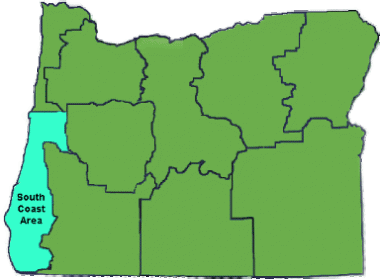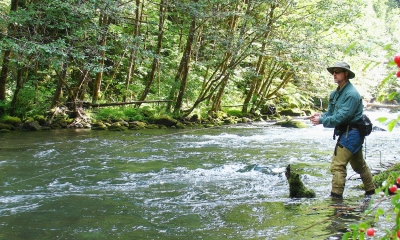
Warmwater fishing on the south coast
The south coast area extends along the Oregon coast from Yachats south to the Oregon-California border. The area offers some of the most productive and scenic warmwater fishing in the state with excellent fishing for bass and panfish available in large waters such as Mercer Lake, Siltcoos Lake, and Tahkenitch Lake.

Tenmile Lakes located north of Coos Bay is renowned for its crappie and trophy bass fisheries, and the site of bass tournaments. Anglers should also try one of the many smaller lakes scattered along Highway 101 and throughout the coastal dunes area, or Triangle Lake closer to the Willamette Valley. The warmwater fish available in the south coast area include: Largemouth Bass | Smallmouth Bass | Bullheads | Black Crappie | Bluegill | Pumpkinseed | Yellow Perch | Green Sunfish | Warmouth | Channel Catfish
Featured waterbody - Tenmile Lakes
North and South Tenmile Lake provide some of the finest warmwater fishing on the Oregon coast. Located on the east side of Hwy 101 mid-way between Reedsport and Coos Bay, the combined lakes offer nearly 2,000 acres of water and miles of shoreline to fish for largemouth bass, bluegill, crappie and brown bullhead catfish. Much of the property around Tenmile is privately-owned and the lakes are best fished by boat, but a fishing dock at Tenmile Lake County Park in the small community of Lakeside is wheelchair accessible and a great spot for kids. There also is a campground and boat launch at the County Park. Spinreel Campground (US Forest Service) on the west side of Hwy 101 offers camping for those wanting an extended stay. Several area resorts and marinas also provide camping spaces, lodging and boat rentals.
The shoreline of North and South Tenmile is varied as a number of streams flow from the coastal foothills and into the lakes creating several large arms and many smaller bays and inlets dotted with pilings, docks and boat houses. Both lakes are shallow with an average depth of about 15 feet and abundant aquatic weeds, willows, and bank vegetation that provide excellent cover and productive habitat for warmwater fish.
Tenmile’s reputation for largemouth bass makes it the site of many bass tournaments. Fish generally range from 1 to 4-pounds, but a 6-pound bass is not uncommon. Bass fishing is best during periods of warmer water from spring through early fall. When spring water temperatures reach about 60 degrees F, the bass move into shallower water to spawn. During the spawn, lures and jigs that imitate prey such as small fish and crayfish, and soft plastic worms work well. Spinnerbaits, buzzbaits and other surface lures are also effective. Anglers should target areas around willows, docks, logs or vegetation that provide a combination of cover and patches of open water. Good locations include the Black’s Creek arm and railroad trestle crossing on North Lake, and the Coleman and Templeton arms of South Lake.
Crappie
Anglers catch crappie in both lakes with good fishing in the spring and throughout the summer. Best fishing is in the calm water along the shoreline, in the many small coves and inlets. Crappie anglers should target shaded areas with wood structure including submerged brush and trees, downed logs and docks. The fish are often found in schools at depths of 10-15 feet. A good set-up is light spinning tackle with 4-pound test line and a light-colored 1/32 ounce jig. Have an assortment of garland-style and curly tail jigs in a variety of bright, neutral, and dark colors and sizes. Use a tapered panfish bobber and change the depth of the jig until you find fish. Allow the jig to sink then retrieve slowly. Fishing is best early and late in the day, but a mid-day breeze can also trigger a bite. Crappie abundance can go through cycles every few years so check with ODFW for the latest information.
Yellow perch
For yellow perch, you can fish the same areas of the lakes and use a similar set-up as for crappie, but try baiting the jig with a piece of worm. A size-8 hook baited with worm and rigged 1-2 feet above a sinker fished on the bottom will also work. Perch will most often be found in deeper water than crappie. Like crappie, perch fishing is best from spring through fall, but they can be caught year-round, even during winter.
Bluegill
Bluegill fishing is best as the water warms during the summer. Bluegill will be found in shallow areas with less woody structure, but more vegetation. During the late summer and early fall they can be caught in the canal between North and South Tenmile. As with crappie, light spinning gear works well, but smaller jigs and hooks are needed. A small hook baited with a piece of worm or other panfish bait and suspended 10-18 inches below a bobber can be deadly! Bluegill are aggressive biters, but if you give them too much time they will steal the bait off your hook -- pay close attention to your bobber. They will feed throughout the day and are a great target for young and beginning anglers.
Brown bullhead
Spinning tackle also works well for the brown bullhead catfish, which are abundant and can reach up to 13-inches long. Worms or baits with a strong odor are effective, particularly when fished near the shore in the evening or at night. Use 6-8 pound test line and a sliding egg sinker placed above a barrel swivel. Below the swivel, tie your hook to the end of an 18-inch leader. The sliding sinker allows the fish to take the bait without feeling the weight of the sinker. If you’re fishing in an area with weeds, a float can be used instead of a sinker to suspend the bait above the weeds.
Other great places to go warmwater fishing in the south coast area:
Find your place to fish:
Header photo by Jeremy Reil, Flickr



